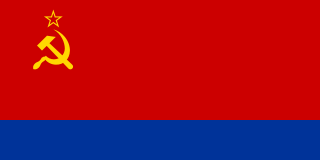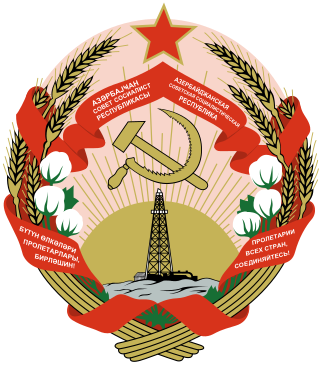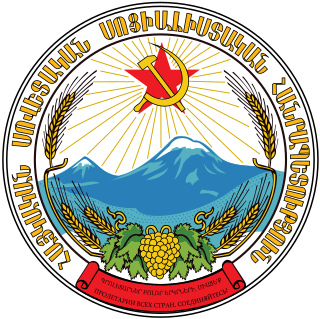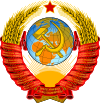
The Transcaucasian Socialist Federative Soviet Republic, also known as the Transcaucasian Soviet Federative Socialist Republic, or simply Transcaucasia, was a republic of the Soviet Union that existed from 1922 to 1936.

The Georgian Soviet Socialist Republic, also known as Soviet Georgia, the Georgian SSR, or simply Georgia, was one of the republics of the Soviet Union from its second occupation in 1921 to its independence in 1991. Coterminous with the present-day republic of Georgia, it was based on the traditional territory of Georgia, which had existed as a series of independent states in the Caucasus prior to the first occupation of annexation in the course of the 19th century. The Georgian SSR was formed in 1921 and subsequently incorporated in the Soviet Union in 1922. Until 1936 it was a part of the Transcaucasian Socialist Federative Soviet Republic, which existed as a union republic within the USSR. From November 18, 1989, the Georgian SSR declared its sovereignty over Soviet laws. The republic was renamed the Republic of Georgia on November 14, 1990, and subsequently became independent before the dissolution of the Soviet Union on April 9, 1991, whereupon each former SSR became a sovereign state.

The Azerbaijan Soviet Socialist Republic, also referred to as the Azerbaijani Soviet Socialist Republic, Azerbaijan SSR, Azerbaijani SSR, AzSSR, Soviet Azerbaijan or simply Azerbaijan, was one of the constituent republics of the Soviet Union between 1922 and 1991. Created on 28 April 1920 when the Russian Soviet Federative Socialist Republic brought pro-Soviet figures to power in the region, the first two years of the Azerbaijani SSR were as an independent country until incorporation into the Transcausasian SFSR, along with the Armenian SSR and the Georgian SSR.

The national flag of Armenia, also known as the tricolour, consists of three horizontal bands of equal width, red on the top, blue in the middle, and apricot on the bottom. The Armenian Supreme Soviet adopted the current flag on 24 August 1990. On 15 June 2006, the Law on the National Flag of Armenia, governing its usage, was passed by the National Assembly of Armenia.

The national coat of arms of Armenia was adopted on April 19, 1992, by resolution of the Armenian Supreme Council. On June 15, 2006, the Armenian Parliament passed the law on the state coat of arms of Armenia.

The flag of the Armenian SSR was adopted on 17 December 1952 by the government of the Armenian SSR. The flag is similar to the flag of the Soviet Union but has a ¼-width horizontal blue stripe in the middle. The red represents the "revolutionary struggle of the working masses" and the golden hammer and sickle represents the peasants' and workers' union.

The flag of the Azerbaijan Soviet Socialist Republic was a plain red flag with a golden hammer and sickle and a gold-bordered red star in its upper canton and an horizontal dark blue band on the bottom fourth, representing the Caspian Sea.
The flags of the Soviet Socialist Republics were all defaced versions of the flag of the Soviet Union, which featured a golden hammer and sickle and a gold-bordered red star on a red field.

The national emblem of the Azerbaijan Soviet Socialist Republic was adopted in 1937 by the government of the Azerbaijan Soviet Socialist Republic. The style is based on the emblem of the Soviet Union.

Grigol Lordkipanidze was a Georgian politician and author.
The ruble, manat or maneti was the currency of both Transcaucasian states, the Transcaucasian Democratic Federative Republic and the Transcaucasian Soviet Federal Socialist Republic.
On 14 April 1978, demonstrations in Tbilisi, capital of the Georgian SSR, took place in response to an attempt by the Soviet government to change the constitutional status of languages in Georgia. After a new Soviet Constitution was adopted in October 1977, the Supreme Soviet of the Georgian SSR considered a draft constitution in which, in contrast to the Constitution of 1936, Georgian was no longer declared to be the sole state language. A series of indoor and outdoor actions of protest ensued and implied with near-certainty there would be a clash between several thousands of demonstrators and the Soviet government, but Georgian Communist Party chief Eduard Shevardnadze negotiated with the central authorities in Moscow and managed to obtain permission to retain the previous status of the Georgian language.
Pro-independence movements in the Russian Civil War within the territory of the former Russian Empire sought the creation of independent and non-Bolshevik nation states after the October Revolution, therefore being in direct conflict with the Russian Soviet Republic which sought to conquer them. They were often supported politically or militarily by the Entente Powers. Some of them co-operated with the Russian White movement, but others were in conflict with it. Many pro-independence movements emerged after the dissolution of the Russian Empire and fought in the Russian Civil War.

Foreign relations exist between Armenia and Georgia. Both countries were former Soviet republics of the Soviet Union. Both countries' governments have had generally positive relations, but there have also been some problems.

Socialist-style emblems usually follow a unique style consisting of communist symbolism. Although commonly referred to as coats of arms, most are not actually traditional heraldic achievements. Many communist governments purposely diverged from heraldic tradition in order to distance themselves from the monarchies that they usually replaced, with coats of arms being seen as symbols of the monarchs.

The Communist Party of Armenia was a branch of the Communist Party of the Soviet Union within the Armenian SSR, and as such, the sole ruling party in the Armenian SSR.

Azerbaijan National Carpet Museum is a museum located in Baku that displays Azerbaijani carpets and rugs with historical and modern weaving techniques and materials. It has the largest collection of Azerbaijani carpets in the world. First opened on Neftchiler Avenue in 1967, it moved to a new building on the Baku's seafront park in 2014.

Azerbaijan–Russia border is the state border between Russia and Azerbaijan. It is 338 km in length and runs from the tripoint with Georgia in the west to the Caspian Sea the east. Prior to 1991 it formed the border between the Russian Soviet Federative Socialist Republic and the Azerbaijan SSR within the Soviet Union. The southernmost point of the Russian Federation is located on the border.

The Declaration and Treaty on the Formation of the Union of Soviet Socialist Republics officially created the Union of Soviet Socialist Republics (USSR), commonly known as the Soviet Union. It de jure legalised a political union of several Soviet republics that had existed since 1919 and created a new federal government whose key functions were centralised in Moscow. Its legislative branch consisted of the Congress of Soviets of the Soviet Union and the Central Executive Committee of the Soviet Union (TsIK), while the Council of People's Commissars composed the executive.

The 1927 Constitution of the Azerbaijan Socialist Soviet Republic was adopted by the Central Executive Committee of the Azerbaijan SSR at the 5th All-Azerbaijani Congress of Soviets on March 26, 1927.



















